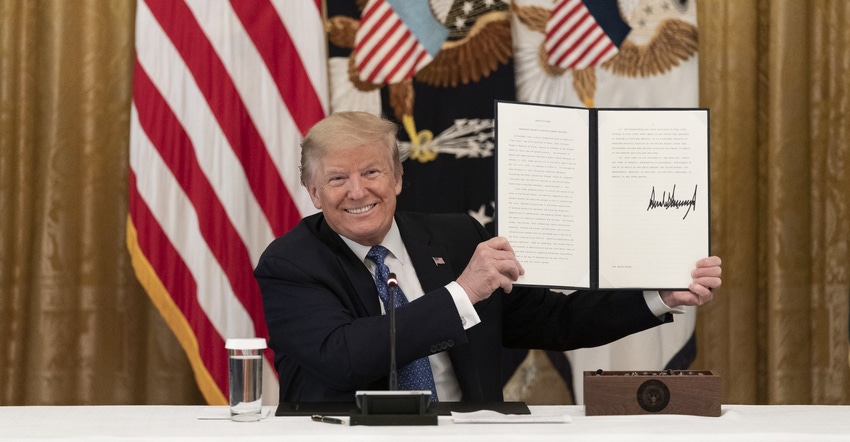Administration wants regulations to support economic recovery
EPA proposes first rule to improve transparency on issuance of guidance documents.

President Donald Trump signed an executive order May 19 instructing federal agencies to use any and all authority to waive, suspend and eliminate unnecessary regulations that impede economic recovery.
During a Cabinet meeting the same day, Trump said he would be directing agencies to review the hundreds of regulations already suspended in response to the virus and make these suspensions permanent, where possible. “I’m also instructing agencies to use the emergency authorities to speed up regulation cuts or new rules that will create jobs and prosperity and get rid of unnecessary rules and regulations,” he said.
In signing the order, Trump noted in his discussions to Cabinet members: “It gives you tremendous power to cut regulation.”
John Bode, president and chief executive officer of the Corn Refiners Assn., said the action is a strong show of commitment to removing regulatory barriers to economic recovery.
“In rural America especially, there is an urgent need for deregulatory actions to spur investment and job creation. Specifically, [the U.S. Environmental Protection Agency] can act swiftly to clarify the de minimis character of biogenic carbon emissions from the processing of annual agricultural crops,” Bode said. “That science-based action would unleash billions of dollars of investment into the rural bioeconomy, create jobs and put the United States on even footing with international competitors in the bioproducts marketplace.”
EPA improving transparency in guidance
In somewhat related news, as directed by Trump’s executive order from October 2019 to promote transparency through improved agency guidance, EPA is announcing its first-ever proposed rule to establish consistent requirements and procedures for the issuance of guidance documents.
A central principle of Executive Order 13891 is that guidance documents should only clarify existing obligations and should not be a vehicle for implementing new binding requirements on the public. Guidance documents can significantly affect the public, and the order recognizes that these documents warrant a thorough review prior to issuance. In addition to today’s action, on Feb. 28, 2020, EPA launched a new guidance portal that provides public access to agency guidance documents.
EPA Administrator Andrew Wheeler said, “Historically, EPA has issued many more guidance documents than most federal agencies. Today’s action is a major step toward increasing transparency in EPA processes and ensuring that EPA is not creating new regulatory obligations through guidance.”
This new rule will significantly increase the transparency of EPA’s practices around guidance and will improve the agency’s process for managing guidance documents. When final, the rule will:
Establish the first formal petition process for the public to request that EPA modify or withdraw a guidance document;
Ensure that the agency’s guidance documents are developed with appropriate review and are accessible and transparent to the public, and
Provide for public participation in the development of significant guidance documents.
Guidance documents typically have not been subject to a fair and transparent process for public review and comment, such as the last Administration’s waters of the U.S. ... guidance. Today’s proposal creates more accountability and transparency in the guidance process, and we look forward to working with the Trump Administration to make sure the Executive Branch interprets and implements laws consistent with the intent of Congress and the will of the American people,” said Rep. Greg Walden (R., Ore.), ranking member of the House Energy & Commerce Committee, and Rep. John Shimkus (R., Ill.), ranking member of the House environment and climate change subcommittee.
Daren Coppock, president and CEO of the Agricultural Retailers Assn., said: “EPA is leading the charge in following the President’s executive order to promote transparency across all government agencies. We are pleased to see this first-ever rule and will be submitting comments in support based on recommendations from our membership. A consistent process to provide public input into the EPA’s development of regulations and guidance documents is critical to ag retailers and the agriculture industry. This will not only provide the opportunity to be sure that our voices are heard but will also ensure that new rules are guided by sound science, practicality and economic feasibility. All federal agencies need to follow a similar path of transparency and public stakeholder input.”
About the Author(s)
You May Also Like





